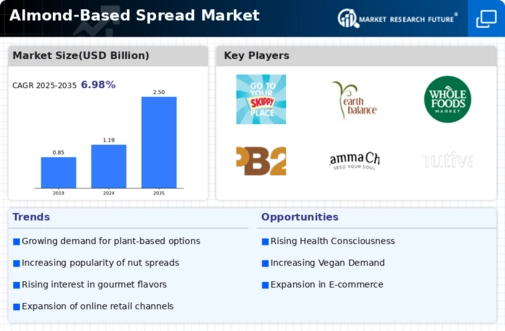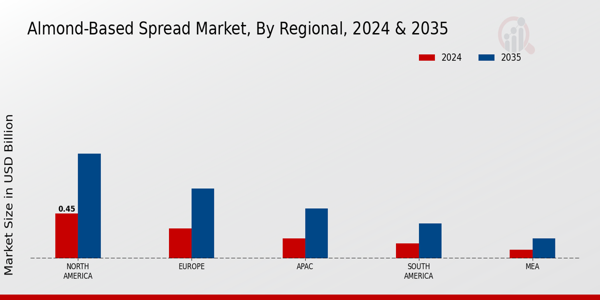Market Growth Projections
The Global Almond-Based Spread Market Industry is projected to experience substantial growth over the next decade. With an estimated market value of 1.19 USD Billion in 2024, the industry is expected to reach 2.5 USD Billion by 2035. This growth trajectory indicates a compound annual growth rate of 6.98% from 2025 to 2035, reflecting increasing consumer interest in almond-based products. Factors such as rising health consciousness, innovative product development, and the expansion of distribution channels are likely to contribute to this upward trend. The market's potential for growth presents opportunities for both established brands and new entrants.
Rising Health Consciousness
The Global Almond-Based Spread Market Industry is experiencing a notable surge in demand driven by increasing health consciousness among consumers. As individuals become more aware of the nutritional benefits of almond-based products, including their high protein and healthy fat content, the market is projected to reach 1.19 USD Billion in 2024. This trend is particularly evident in regions such as North America and Europe, where consumers are actively seeking healthier alternatives to traditional spreads. The growing preference for plant-based diets further fuels this demand, suggesting a robust growth trajectory for almond-based spreads in the coming years.
Innovative Product Development
Innovation plays a crucial role in the Global Almond-Based Spread Market Industry, as manufacturers continuously develop new flavors and formulations to cater to diverse consumer preferences. The introduction of organic, sugar-free, and flavored almond spreads has attracted a broader customer base, appealing to those seeking unique taste experiences. This trend not only enhances consumer interest but also drives sales growth. As the market evolves, companies are likely to invest in research and development to create novel products, further solidifying their positions in the competitive landscape. Such innovations are expected to contribute to the projected market value of 2.5 USD Billion by 2035.
Expansion of Distribution Channels
The Global Almond-Based Spread Market Industry benefits from the expansion of distribution channels, which enhances product accessibility. Retailers are increasingly incorporating almond-based spreads into their offerings, with supermarkets and health food stores leading the way. E-commerce platforms are also gaining traction, allowing consumers to purchase these products conveniently from home. This diversification in distribution channels is likely to contribute to the market's growth, as it enables brands to reach a wider audience. As a result, the market is expected to witness a compound annual growth rate of 6.98% from 2025 to 2035, reflecting the positive impact of improved accessibility.
Growing Vegan and Plant-Based Trends
The Global Almond-Based Spread Market Industry is significantly influenced by the growing vegan and plant-based trends. As more consumers adopt plant-based diets for ethical, environmental, or health reasons, the demand for almond-based spreads is likely to increase. These spreads serve as a nutritious alternative to dairy-based products, aligning with the preferences of health-conscious and environmentally aware consumers. The rise in veganism is particularly pronounced among younger demographics, who are more inclined to explore plant-based options. This shift in consumer behavior suggests a promising future for almond-based spreads, potentially driving market growth in the coming years.
Consumer Demand for Sustainable Products
Sustainability is becoming a pivotal factor in the Global Almond-Based Spread Market Industry, as consumers increasingly prefer products that align with their values. Almond-based spreads are often perceived as more sustainable compared to traditional spreads, particularly when sourced from environmentally responsible farms. This growing demand for sustainable products is prompting manufacturers to adopt eco-friendly practices in sourcing and production. As consumers prioritize sustainability, brands that effectively communicate their commitment to ethical sourcing and environmental stewardship are likely to gain a competitive edge. This trend may further enhance the market's growth potential, reflecting a broader shift towards conscious consumerism.

























Leave a Comment